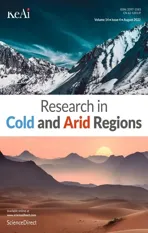Frozen curtain characteristics during excavation of submerged shallow tunnel using Freeze-Sealing Pipe-Roof method
2023-01-02YeNiuZeQunHongJunZhangLeiHan
Ye Niu,ZeQun Hong,Jun Zhang,Lei Han
1.China Railway Siyuan Survey and Design Group Co.,Ltd.,Wuhan,Hubei 430056,China
2.School of Mechanics and Civil Engineering,China University of Mining and Technology,Xuzhou,Jiangsu 221116,China
3.CCCC Second Highway Consultants Co.,Ltd.,Wuhan,Hubei 430056,China
4.Department of Geotechnical Engineering,Tongji University,Shanghai 200092,China
ABSTRACT The Freeze-Sealing Pipe-Roof(FSPR)method,which has been applied for the first time in the Gongbei Tunnel of the Hong Kong-Zhuhai-Macao Bridge,is a new approach of tunnel pre-support that allows flexible adjustment of freeze tube arrangement and can be adapted to different environmental conditions.When the FSPR method is used to construct shallow burial submerged tunnels,the frozen wall to hold back groundwater during excavation will be weakened by air and water flows inside and outside the tunnel,and its waterproof performance needs to be further investigated.In this paper,a two-dimensional numerical model of the temperature field considering excavation and moving water boundary is established based on the preliminary design scheme and in-situ conditions and is used to analyze the variation in frozen curtain properties with various active freezing times during excavation.The results show that excavation has a weakening effect on both sides of the frozen wall,with a greater effect on the inner side,and a positive temperature appears in the local area inside the jacked pipe.The concrete fill in the jacked pipe obviously improves the freezing efficiency,and the tunnel excavation after 60 days of active freezing in the interval filling mode can ensure that the frozen soil thickness at the thinnest segment exceeds 2 m,i.e.,the design requirement.In practice,the active freezing time can be extended appropriately to reduce the influence of river water flow above the tunnel.The study serves as a technical reference for the design and implementation of similar projects.
Keywords:Freeze-Sealing Pipe-Roof method;submerged tunnel;soil excavation;temperature field;frozen wall thickness
1 Introduction
The shallow burial concealed method was proposed for application in a complex urban tunnel and underground engineering environment(Wang,2004).After more than 20 years of development,a complete set of supporting technologies has been designed and widely used in tunnel and underground engineering(Zheng and Zhang,2014).As the construction environment of urban tunnels and underground engineering becomes more and more complex,it is increasingly difficult to apply existing construction technologies.The development trend of the traditional shallow mining method is mainly manifested in strengthening the auxiliary measures and simplifying the original main procedures(Guo,2012).For shallow tunnels with water-rich strata,the choice of auxiliary methods is particularly important.When ordinary methods such as horizontal rotary spray,pipe curtain,ground freezing or precipitation method alone cannot meet the requirements,a combination of multiple auxiliary methods is proposed to complement each other(Shenet al.,2006;Huet al.,2013).
The construction of the concealed section of the Gongbei tunnel of the Hong Kong-Zhuhai-Macao Bridge adopted a combination of the pipe curtain method and artificial ground freezing(AGF)method,namely the Freeze-Sealing Pipe-Roof method(Cheng and Liu,2012).This was the first-ever engineering application of such a method,although the"steel pipe+freezing"method was previously studied in Japan(Moriuchiet al.,2008).Examples of similar applications only appeared in the subsurface excavation of U55 subway station in Berlin,Germany.However,there is still a fundamental difference between these studies and the new FSPR method.Foreign studies consider frozen soil as a load-bearing structural,and steel pipe is used to improve the overall load-bearing performance.In contrast,the pipe roof is designed as a load-bearing structure in the FSPR method,and the frozen soil curtain is only a substitute for the locking catch to play a role in sealing water.
A research team from Tongji University in China has conducted many studies on the concept of the FSPR method and its reliability of water sealing through numerical simulations(Hu and She,2012),indoor tests(Wang,2013)and large physical model tests in conjunction with the Gongbei tunnel(Chen,2013).Applications of the FSPR method in constructing shallow tunnels under rivers have not been reported before.This paper describes a detailed investigation into the frozen curtain development during excavation of a submerged tunnel based on the numerical simulation of ground freezing of the Qinhuai River Tunnel using the FSPR method.The variation of the thickness and critical location temperature of the frozen curtain is revealed to provide a reference for field design and construction.
2 Engineering Background
2.1 Environment around tunnel site
The Ning-Wu Railway connects Nanjing and Wuhu City in East China.The rapid development in this region urgently necessitates improving the transportation capacity of the existing railroad.At the same time,it is very important to reduce the impact on the lives of the neighboring residents.Under this background,the expansion and reconstruction project of the Ning-Wu Railway was put on the agenda in recent years.
The newly modified line crosses the new Qinhuai River from mileage DK24+400 to DK24+600,which is called the Qinhuai Tunnel.This tunnel is 385 meters long,with a 200-meter underwater section intersecting obliquely with the Qinhuai New River at an angle of about 41°.It is only 32 m from the proposed Beijing-Shanghai high-speed railroad upstream,as shown in Figure 1.
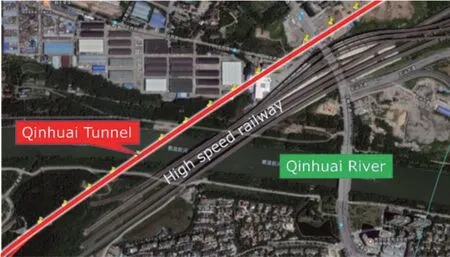
Figure 1 Schematic diagram of the Qinhuai Tunnel route and nearby infrastructure
2.2 Engineering geology conditions
A preliminary engineering geological survey was carried out prior to the construction of the Qinhuai tunnel.The survey results show that there are various soil and rock layers distributed from the river bottom to the tunnel bottom,as illustrated by the general geotechnical profile near the north working shaft in Figure 2.The soil index properties of each layer are summarized in Table 1.

Figure 2 Geotechnical profile of the Qinhuai Tunnel

Table 1 Index properties of main geologic units
2.3 Design of the FSPR method
The original plan to build by open excavation had to be changed to concealed excavation due to the need for flood control in the summer of the Qinhuai River.This left an extremely shallow overburden at the tunnel top and a minimum distance of less than 2 m between the structure and the river.Traditional tunnel construction methods such as the shield method are not applicable in this hydrogeological environment.After construction plan selection,it is proposed to use the FSPR method for concealed excavation.The preliminary scheme of the pipe curtain group consists of 26 steel pipes with a diameter of 1.62 meters,which are jacked in sequence along the quasi-rectangular tunnel profile to form the bearing structure.The spacing between adjacent jacked pipes is about 25 cm,and the load-bearing capacity is increased by filling every other pipe with concrete.The freeze tubes of 0.108 m in diameter are arranged inside the steel pipes,and the designed thickness of the frozen wall is 2 m.For description convenience,a total of 26 jacked pipes are numbered in clockwise order,with No.1 pipe at the top of the tunnel,as shown in Figure 3.
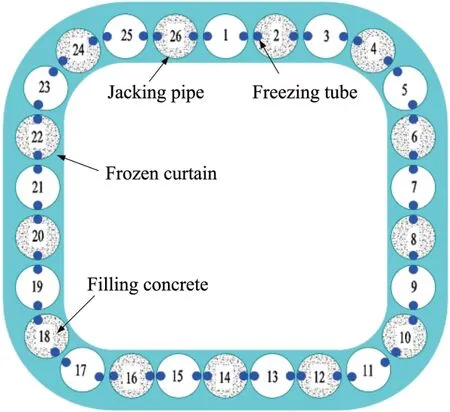
Figure 3 Tunnel cross-section and arrangement of jacked pipes and freeze tubes
3 Numerical model and parameter selection
The computational model also necessitates simplification due to the small difference in the freezing state along the longitudinal direction of the tunnel in the actual construction,and the evaluation of the freezing effect only requires qualitative analysis of the temperature field.Therefore,the study is simplified to a planar thermal conductivity problem,i.e.,a two-dimensional temperature field,without considering the longitudinal variation in the temperature field.
According to the preliminary freezing scheme described previously,a two-dimensional finite element(FE)model with a width of 67.6 m and a height of 52.6 m was selected,considering the temperature field influence range and geometric symmetry.The FE mesh close to the jacked pipes was refined to better simulate the freezing effect,and the excavation was simulated using the birth and death unit technique.PLANE55 element was selected to simulate the soil,and the enthalpy change in the frozen soil was considered by phase change.The computational model and enlarged mesh division diagram for the excavation period are shown in Figure 4.
The boundary conditions of this model mainly include several parts such as geometric boundary,freeze tube boundary,water-soil interface and air-soil interface.For the geometric boundary,the left and right sides can be set as adiabatic by the symmetry of the model.For the freeze tube boundary,which is the source of the cooling capacity,studies have shown that directly setting the outer wall of the freeze tubes at a constant temperate same as the brine inlet does not cause large errors(Yang and Che,2004).The brine temperature in the active freezing stage is varied gradually,with the temperature maintained at-18 °C for 7 days,-24 °C for 11 days and-28 °C for 17 days.Afterward,the brine is cycled at-28 °C during the excavation process.For the water-soil interface,the convective heat exchange boundary is set,and the heat exchange coefficient is taken as 50 J/(s·m2·°C).For the internal air-soil interface after excavation,with reference to previous engineering experience,the heat transfer coefficient of 15 J/(s·m2·°C)is applied on the heat dissipation surface.
In addition,the initial temperature of ground and river water is set at 20 °C,air temperature at the excavation surface is taken as 30 °C,and the freezing point of in-situ soil is-2.1 °C.Referring to the report on physical and mechanical properties of artificially frozen soil in Yangtze River(Hu and She,2012),the thermophysical parameters of other materials such as mild steel,earth,air and concrete are shown in Table 2.
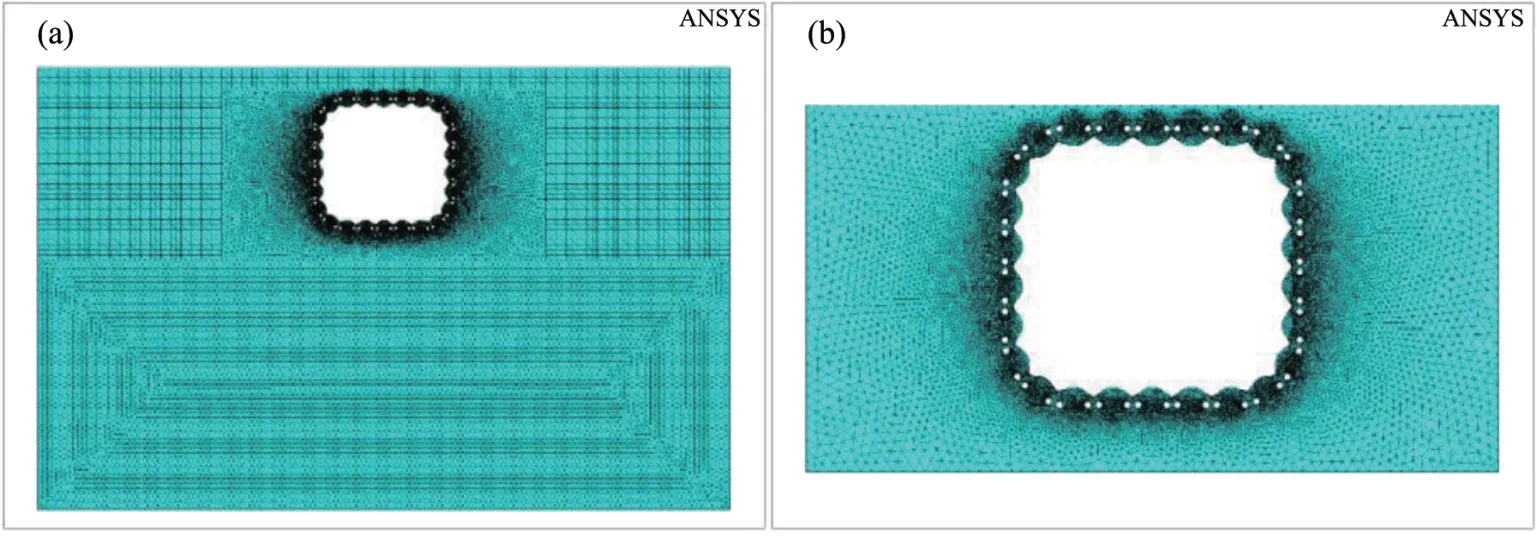
Figure 4 Numerical model and enlarged mesh near the jacked pipes

Table 2 Thermophysical parameters of materials in the finite element model
4 Results and discussions
4.1 Temperature cloud maps under differentfreezing times
After preliminary trial calculations,the thermal field of three most likely active freezing plans was simulated,namely:32 days,45 days,and 60 days.Each case includes active freezing before excavation and maintenance freezing for 60 days during excavation.Figure 5 through Figure 7 show the initial pre-excavation and after-excavation temperature clouds for each case.
One can see from the cross-section temperature clouds in Figure 5 through Figure 7 that the temperature field inside the tunnel will be drastically affected by the high-temperature airflow after excavation,regardless of which active freezing case.The presence of positive temperature zones near the excavation surface inside the pipe roof indicates a partial thaw of the frozen soil.Although the frozen curtain thickness outside of the tunnel also decreases after excavation,it has a much greater impact on the inner frozen wall than on the outer one.Comparison between the three cases shows that the thickness of the frozen soil on the tunnel profile also increases significantly with the increase in the active freezing time,especially in the area above the tunnel near the river.This result proves that the extension of active freezing time is an effective measure to counteract the weakening effect of the moving water.
Furthermore,one can also notice that the concretefilled jacked pipes have a larger blue area around them,indicating that the concrete fill not only enhances the load-bearing capacity of the pipe roof but also increases the rate of heat transfer and improves the freezing efficiency to a large extent.
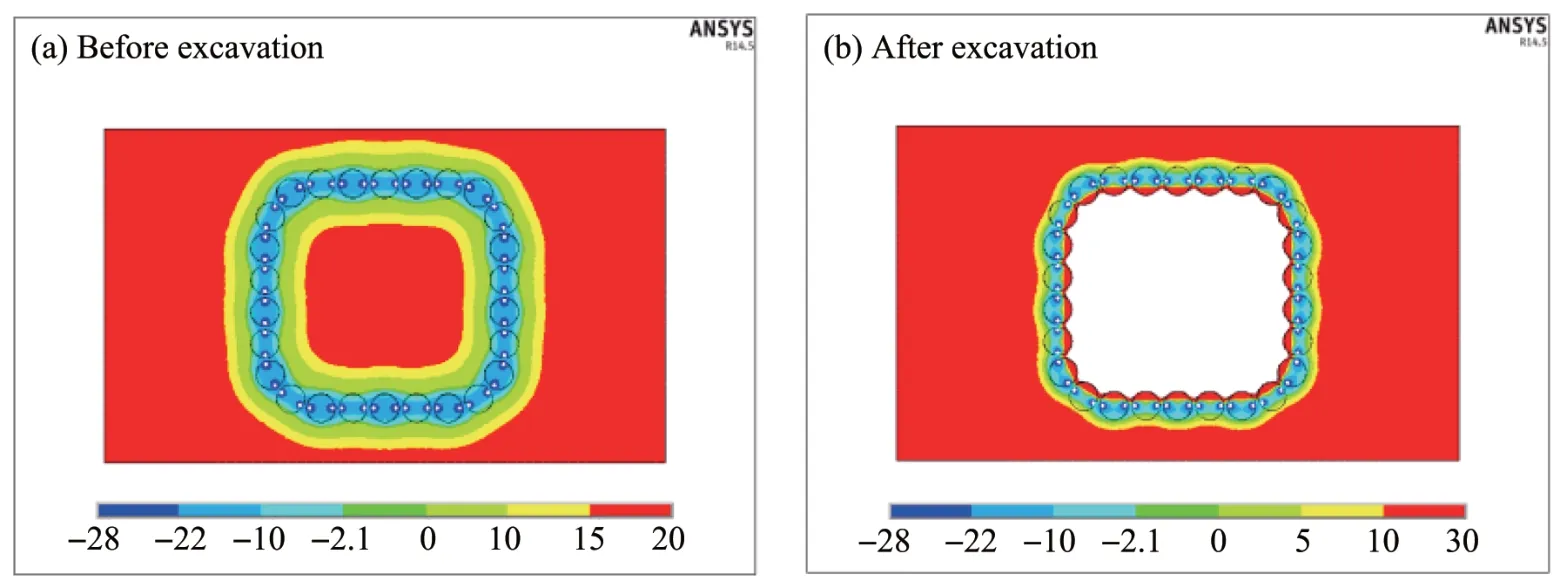
Figure 5 Temperature cloud maps before and after excavation for 32 days of active freezing
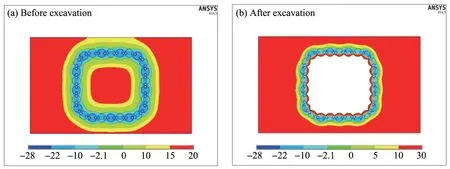
Figure 6 Temperature cloud maps before and after excavation for 45 days of active freezing
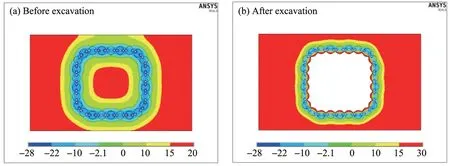
Figure 7 Temperature cloud maps before and after excavation for 60 days of active freezing
4.2 Variation of temperature at key locations during excavation
Temperature data at selected key locations were retrieved to evaluate the effect of tunnel excavation on the freezing performance of the FSPR method quantitatively.Points A and B within jacked pipe #1 at the top and C and D within jacked pipe #4 at the right corner of the tunnel were selected as shown in Figure 8.Specifically,Points A and C are at the center,and C and D are by the pipe wall.
Figure 9 through Figure 11 illustrate the temperature change with time for each observation point during excavation after 32,45 and 60 days of active freezing,respectively.One can see from these figures that excavation after 32,45 and 60 days of active freezing produced a significant warming at each key point in the first 5 days of of the excavation.Then,the thermal erosion from inside the tunnel and the cooling supply of the cryogenic brine in freeze tubes during the maintenance freezing stage reached an equilibrium state,and the temperature began to stabilize and remain constant until the end of excavation.It should be noted that the temperature profile was calculated assuming that the full section is excavated in one step and should be recalculated according to the actual excavation sequence,which could involve the multi-block or multi-step method due to site constraints.
Points C and D are located at the center and by the wall of the concrete-filled pipe,respectively.As can be seen from Figure 9 through Figure 11,the temperature at point D is higher than that at point C throughout the excavation process,indicating that the temperature on the pipe wall is higher than that at the pipe center with a temperature difference of about 5 °C after 60 days of active freezing.In contrast,such a difference is doubled to about 10 °C for the pipe without concrete fill.It can also be seen that for the case of 60 days of active freezing,the temperature at point B at thermal equilibrium,which is the highest among all key points,can be maintained near 0 °C.This condition is favorable to ensure the water sealing performance of the whole frozen curtain.Therefore,it is recommended to extend the active freezing time to more than 60 days to ensure the water sealing capability of the frozen curtain by the FSPR method during tunnel excavation,if allowed by the construction schedule.
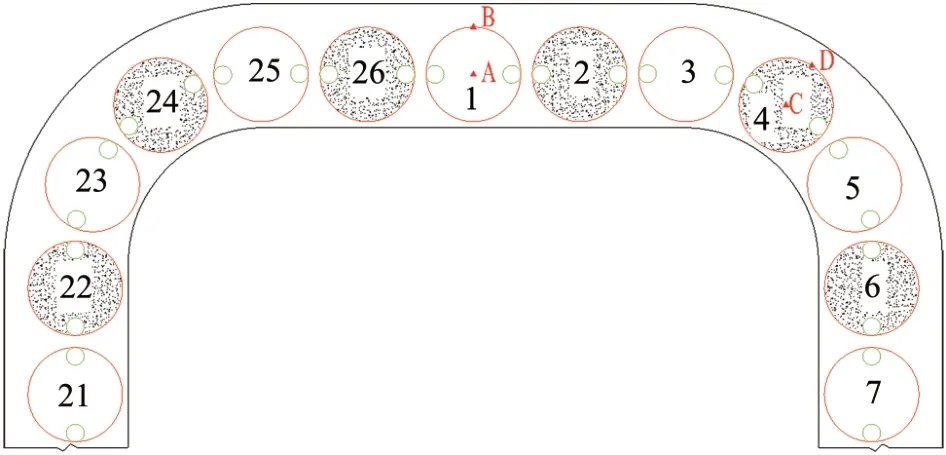
Figure 8 Location of selected key observation points within the frozen soil curtain
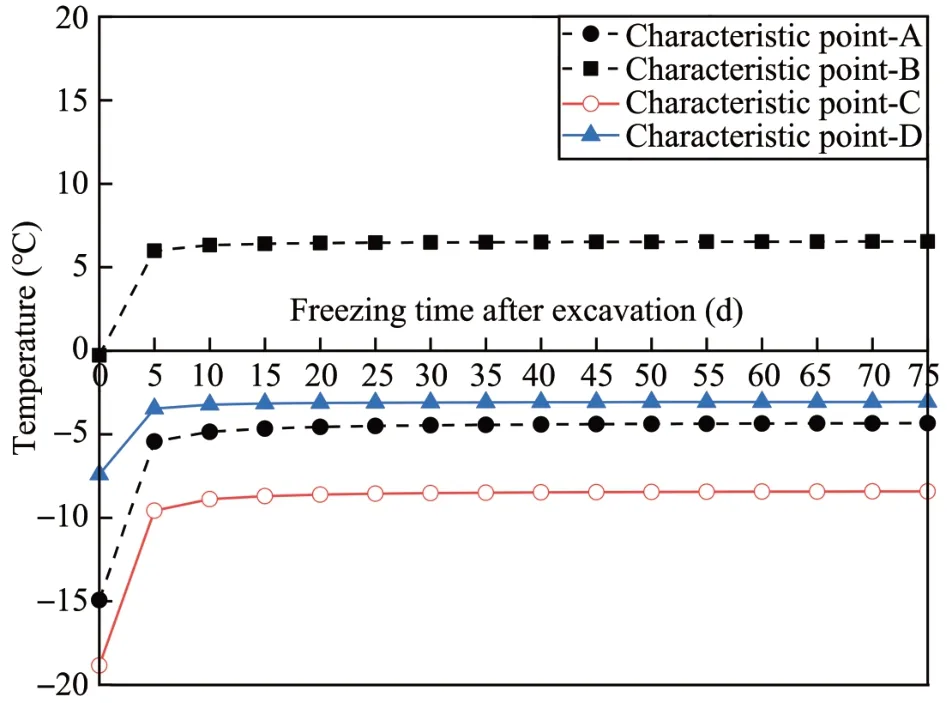
Figure 9 Variation of temperature at key points with time after 32 days of active freezing

Figure 10 Variation of temperature at key points with time after 45 days of active freezing
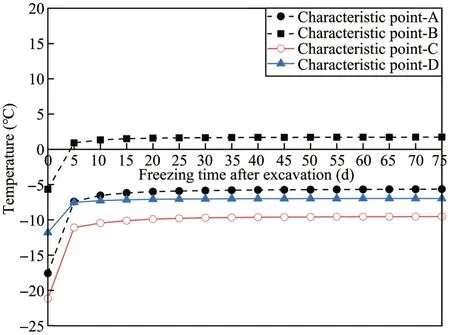
Figure 11 Variation of temperature at key points with time after 60 days of active freezing
4.3 Variation of the frozen curtain thickness with time
In AGF,the thickness of the frozen wall is one of the most important parameters.It determines the bearing capacity and strength of the frozen soil,and it is no exception for the FSPR method.Considering the effects of concrete fill on the temperature field development,a pipe filled with concrete and an unfilled one are selected in this section to discuss the frozen wall thickness during the excavation.Figure 12 and Figure 13 show the thickness development of the frozen curtain outside the unfilled and concrete-filled jacked pipes during excavation after various periods of active freezing.It can be seen from the figures that the initial frozen thickness outside the concrete-filled pipe before excavation is significantly greater than that of the unfilled case,and the difference between these two thicknesses is the largest when active freezing lasts for 45 days,reaching about 0.6 m.At thermal equilibrium after excavation,the frozen soil thickness outside the unfilled pipe for 60 days of active freezing is roughly 0.2 m thicker than that for 45 days of active freezing,which increases to 0.28 m for the concrete-filled pipe.Around the unfilled pipe is the weakest freezing zone in the FSPR method.Figure 12 shows that the initial frozen wall thickness after 60 days of active freezing is approximately 2.05 m,which exceeds the design requirement of 2 m.Meanwhile,extending the active freezing time before excavation can significantly increase the thickness of the frozen curtain,which is more conducive to ensuring the reliability of water sealing performance.
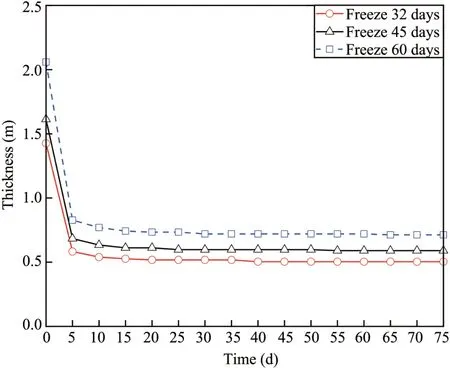
Figure 12 Thickness of the frozen curtain on the outside of the unfilled pipe(#1)

Figure 13 Thickness of the frozen curtain on the outside of the concrete-filled pipe(#2)
5 Conclusions
This paper investigates the effects of active freezing on the thermal state of the submerged Qinhuai Tunnel during excavation via the FSPR method by conducting a two-dimensional finite element analysis.The following conclusions can be drawn:
(1)The inside of the frozen curtain experiences greater aerothermal disturbance than the outside,and localized thaw occurs at the wall edge of the jacked pipe during tunnel excavation.
(2)Extending the active freezing time can effectively increase the frozen wall thickness,especially for resisting the thermal erosion of the river flow above the tunnel.
(3)Filling concrete in the jacked pipe not only improves the load-bearing capacity of the frozen curtain but also significantly enhances the thermal conductivity and strengthens the efficiency of the FSPR method.
(4)After 60 days of active freezing,the thickness of the frozen curtain outside the unfilled pipe can reach more than 2 m,meeting the design requirements.This key design parameter reduces to about 0.8 m after tunnel excavation,which still can form a sufficient and stable waterproof curtain.
Acknowledgments:
This research was supported by the National Natural Science Foundation of China(No.52108386).The authors are deeply indebted to the financial support.
杂志排行
Sciences in Cold and Arid Regions的其它文章
- The influence of the underpassing frozen connecting passage on the deformation of the existing tunnel
- Influence of freeze tube deviation on the development of frozen wall during long cross-passage construction
- Thermal-Hydro-Mechanical coupled analysis of unsaturated frost susceptible soils
- Discussion on pile axial load test methods and their applicability in cold regions
- Application of automated cone penetrometer for railway investigation using correlations with DCPI and Deflection Modulus
- Triaxial test on glass beads simulating coarse-grained soil
